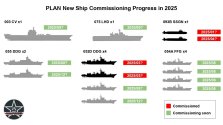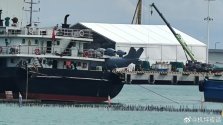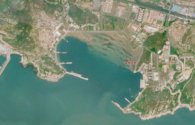That was a cool essay, thanks for sharing. I did not know this 2023 paper.Exposed Undersea: PLA Navy Officer Reflections on China’s Not-So-Silent Service
You are using an out of date browser. It may not display this or other websites correctly.
You should upgrade or use an alternative browser.
You should upgrade or use an alternative browser.
PLA Navy news, pics and videos
- Thread starter Jeff Head
- Start date
If I’m reading that correctly that will be 14 ships commissioned this year.076 is not on the list, maybe it will commission in 2026.
View attachment 155164
Yes, 14 in 2025.If I’m reading that correctly that will be 14 ships commissioned this year.
As part of reunification celebration week, a Carrier formation of Shandong , type 55, type 52d, and type 54a will be in Hong Kong July 3-7.
The PLA Hong Kong Garrison will open reservation for 10,000 visit tickets starting June 30, 2,000 for the Shandong and 8,000 for the Zhanjiang and Yuncheng, according to CCTV News
The PLA Hong Kong Garrison will open reservation for 10,000 visit tickets starting June 30, 2,000 for the Shandong and 8,000 for the Zhanjiang and Yuncheng, according to CCTV News
Not really. Just a mistake by OP. The water had always been shallow in that area.Interesting development at the Jianggezhuang Naval Base at Qingdao, which houses some of the PLAN SSNs and SSBNs.
Discussion continued here, as ground-effect vehicles (GEVs) are more suited in the maritime domain than the aerial domain.
Technically speaking, ekranoplans aren't exactly hard to target once detected, especially with the proliferation of AEW and AEW&C platforms with look-down capabilities. And given how ekranoplans are essentially huge chunks of metal (displacement would be in the 100s of tons), less-than-ideal maneuverability and no supersonic capability - They are sitting ducks for enemy's AAMs once spotted. Though, if said ekranoplans have the capability to fly out of ground effect, then it'll be the same as any other conventional aircrafts.
In the meantime, yes - Such ekranoplans could be fitted with mini VLS cells or missile pods fitted with CIWS-SAMs (such as HHQ-10) for self-defense.
As for the purpose of such vehicles - Rapid troop and cargo transportation, not just for strait-dashing, but also for far-flung island bases in the SCS and ECS could be very useful, especially to increase chances of avoiding detection, plus in case the runways on those islands have been rendered inoperable. The cargo capacity potential should be taken into account as well.
(For instance, the Liberty Lifter Project currently undertaken by DARPA is slated to have a cargo capacity of ~70-80 tons, which is about that of the C-17.)
ASW usage might also be promising, whether as manned or unmanned platforms. However, there isn't really much potential for ekranoplans to conduct actual anti-ship/land-attack strike missions like the Lun-class, as there are already plenty of other options available to the PLA which would be more effective in such roles.
Sure, it could be a Class B (although that would still count as a maritime vessel AFAICT). I think at least some ability to rise a bit is probably really helpful for dealing with potential weather issues like chop.
On that note, I think something that makes ekranoplans much more feasible in the modern day is not just the typical improved control systems, but just the fact that weather forecasts are so much better than they used to be. We have much greater ability to reliably forecast weather 10+ days in advance, rather than 3. That could let the PLAN move them to less weather-affected bases well in advance, or chart a course around non-navigable weather events.
Plus, as far as I'm aware we still don't really know how to target them. As far as we know any US torpedo would be useless against them (they're ~10× faster than the Mark 48's estimated speed), even a supercavitating torpedo like the VA-111 may not be fast enough to match their speed. A strike missile/AShM like the Tomahawk or LRASM could travel fast enough to easily exceed the speed of an ekranoplan, but I don't know how much such a high speed would complicate everything involved in completing that kill chain.
I am really intrigued by the idea of having an ekranoplan armed with a SAM system, to defend itself from the most likely threat it faces and to be able to put a capable SAM somewhere out on the ocean much faster than any other option. I'm also intrigued by the idea of an ekranoplan for ASW, using their combination of high load capacity and speed to drop large volumes of hydrosensors, or even to rapidly deploy some Mark 32-like munitions to a location where an enemy submarine was detected before other assets can get there.
Technically speaking, ekranoplans aren't exactly hard to target once detected, especially with the proliferation of AEW and AEW&C platforms with look-down capabilities. And given how ekranoplans are essentially huge chunks of metal (displacement would be in the 100s of tons), less-than-ideal maneuverability and no supersonic capability - They are sitting ducks for enemy's AAMs once spotted. Though, if said ekranoplans have the capability to fly out of ground effect, then it'll be the same as any other conventional aircrafts.
In the meantime, yes - Such ekranoplans could be fitted with mini VLS cells or missile pods fitted with CIWS-SAMs (such as HHQ-10) for self-defense.
As for the purpose of such vehicles - Rapid troop and cargo transportation, not just for strait-dashing, but also for far-flung island bases in the SCS and ECS could be very useful, especially to increase chances of avoiding detection, plus in case the runways on those islands have been rendered inoperable. The cargo capacity potential should be taken into account as well.
(For instance, the Liberty Lifter Project currently undertaken by DARPA is slated to have a cargo capacity of ~70-80 tons, which is about that of the C-17.)
ASW usage might also be promising, whether as manned or unmanned platforms. However, there isn't really much potential for ekranoplans to conduct actual anti-ship/land-attack strike missions like the Lun-class, as there are already plenty of other options available to the PLA which would be more effective in such roles.
Last edited:
Discussion continued here, as ground-effect vehicles (GEVs) are more suited in the maritime domain than the aerial domain.
Technically speaking, ekranoplans aren't exactly hard to target once detected, especially with the proliferation of AEW and AEW&C platforms with look-down capabilities. And given how ekranoplans are essentially huge chunks of metal (displacement would be in the 100s of tons), less-than-ideal maneuverability and no supersonic capability - They are sitting ducks for enemy's AAMs once spotted. Though, if said ekranoplans have the capability to fly out of ground effect, then it'll be the same as any other conventional aircrafts.
In the meantime, yes - Such ekranoplans could be fitted with mini VLS cells or missile pods fitted with CIWS-SAMs (such as HHQ-10) for self-defense.
As for the purpose of such vehicles - Rapid troop and cargo transportation, not just for strait-dashing, but also for far-flung island bases in the SCS and ECS could be very useful, especially to increase chances of avoiding detection, plus in case the runways on those islands have been rendered inoperable. The cargo capacity potential should be taken into account as well.
(For instance, the Liberty Lifter Project currently undertaken by DARPA is slated to have a cargo capacity of ~70-80 tons, which is about that of the C-17.)
ASW usage might also be promising, whether as manned or unmanned platforms. However, there isn't really much potential for ekranoplans to conduct actual anti-ship/land-attack strike missions like the Lun-class, as there are already plenty of other options available to the PLA which would be more effective in such roles.
ASW looks interesting.
By flying just above the surface, MAD sensors should be more effective.
Plus it has the option of landing and then using a sonar (dipping or integrated sonar?)
A submarine could launch a torpedo, but that should be detectable and the ekranoplan can outrun any torpedo.
It should also be less vulnerable to submarine launched SAMs, as the ekranoplan is operating at the sea surface rather than flying high.



